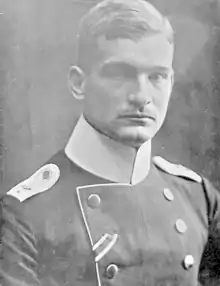Max Ritter von Mulzer | |
|---|---|
 | |
| Born | 9 July 1893 Kimratshofen, Allgäu, Kingdom of Bavaria |
| Died | 26 September 1916 (aged 23) Valenciennes, France |
| Allegiance | Germany |
| Service/ | Cavalry; aviation |
| Years of service | 1914–1916 |
| Rank | Leutnant |
| Unit | 8th Cavalry Regiment; Feldflieger Abteilung 4 (FFA 4); Flieger-Abteilung 62 (FA 62}; Kampfeinsitzerkommando Nord (KEK Nord); Kampfeinsitzerkommando "B" (KEK B); Flieger-Abteilung 32 (FA 32) |
| Awards | Pour le Merite; Military Order of Max Joseph; Iron Cross |
Leutnant Max Ritter von Mulzer was a German World War I flying ace credited with ten aerial victories.[1] He was the first Bavarian fighter ace, first Bavarian ace recipient of the Pour le Merite, and first Bavarian knighted for his exploits.[2]
Biography
Early life
Max Mulzer was born on 9 July 1893 in the Kingdom of Bavaria in the German Empire.[2]
Military service
Mulzer graduated from cadet training with the Royal Bavarian Cadet Corps on 10 July 1914,[3] and was commissioned in the 8th Cavalry Regiment on 13 December 1914. He transferred to aviation on 20 August 1915. He was posted to FA 4 on 13 December, but soon joined Oswald Boelcke and Max Immelmann in FFA 62.[2] Indeed, Mulzer and Immelmann often flew together, and were referred to, respectively, as "Bavarian Max" and "Saxon Max" to differentiate them.[4] "Bavarian Max"'s first victory, on 13 March 1916, went unconfirmed, but he had three confirmed victories between 30 March and 31 May.[1] When FA 62 shipped out for service in Russia, Mulzer transferred to KEK Nord in June 1916[2] and tallied three more wins during the month,[1] with the second one occurring during the dogfight during which his friend Immelmann was killed.[5]
Mulzer had the honor of carrying Immelmann's decorations on the black velvet Ordenkissen cushion in the funeral procession.[6] Afterwards, he then had a fleeting assignment to FFA 32, and went on to KEK 'B'. He scored twice for them, on 8 and 22 July; the eight victories were enough at that time to earn him the Blue Max.[7] He also received the Military Order of Max Joseph and thus earned a lifetime pension and became a non-hereditary knight entitled to be addressed by the honorific "Ritter von".[8] He moved on to FA 32, and scored twice more.[2][1]
On 26 September, the day after Kurt Wintgens died, Mulzer had a new airplane to test fly. Apparently prompted by news of his old comrade's death, Mulzer remarked, "Immelmann is dead. Parschau is dead, Wintgens is dead. Now I am next in line." Then he took off from the Valenciennes airfield on a test flight, side-slipped his Albatros D.I into a hard bank, lost control, and crashed to his death.[9]
References
- 1 2 3 4 The Aerodrome website http://www.theaerodrome.com/aces/germany/mulzer.php Retrieved on 19 April 2010.
- 1 2 3 4 5 Above the Lines: The Aces and Fighter Units of the German Air Service, Naval Air Service and Flanders Marine Corps 1914–1918. p. 171.
- ↑ Early German Aces of World War I. p. 51.
- ↑ Early German Aces of World War I. p. 52.
- ↑ Above the Lines: The Aces and Fighter Units of the German Air Service, Naval Air Service and Flanders Marine Corps 1914 - 1918. p. 134, 171.
- ↑ Early German Aces of World War I. p. 60-61.
- ↑ Early German Aces of World War I. p. 64.
- ↑ The Aerodrome website page on the Max Joseph Retrieved on 28 September 2020.
- ↑ Early German Aces of World War I. pp. 82–83.
- General sources
- Above the Lines: The Aces and Fighter Units of the German Air Service, Naval Air Service and Flanders Marine Corps 1914 - 1918 Norman L. R. Franks, et al. Grub Street, 1993. ISBN 0-948817-73-9, ISBN 978-0-948817-73-1.
- Early German Aces of World War I. Greg VanWyngarden, Harry Dempsey. Osprey Publishing, 2006. ISBN 1-84176-997-5, ISBN 978-1-84176-997-4.
External links
 Media related to Max Ritter von Mulzer at Wikimedia Commons
Media related to Max Ritter von Mulzer at Wikimedia Commons